Masada
Masada (Hebrew: מצדה metsada, "fortress")[1] is an ancient fortification in the Southern District of Israel situated on top of an isolated rock plateau, akin to a mesa. It is located on the eastern edge of the Judaean Desert, overlooking the Dead Sea 20 km (12 mi) east of Arad.
מצדה | |
 Aerial view of Masada, from the north | |
 Shown within Israel | |
| Location | Southern District, Israel |
|---|---|
| Region | Judea |
| Coordinates | 31°18′56″N 35°21′14″E |
| Type | Fortification |
| History | |
| Builder | Alexander Jannaeus (?) Herod the Great |
| Founded | 1st century BCE |
| Events | Siege of Masada |
| Site notes | |
| Excavation dates | 1963–1965 |
| Archaeologists | Yigael Yadin |
| Criteria | Cultural: iii, iv, vi |
| Reference | 1040 |
| Inscription | 2001 (25th session) |
| Area | 276 ha |
| Buffer zone | 28,965 ha |
Herod the Great built two palaces for himself on the mountain and fortified Masada between 37 and 31 BCE.
According to Josephus, the siege of Masada by Roman troops from 73 to 74 CE, at the end of the First Jewish–Roman War, ended in the mass suicide of the 960 Sicarii rebels who were hiding there.
Masada is one of Israel's most popular tourist attractions.[2]
Geography
The cliff of Masada is, geologically speaking, a horst.[3] As the plateau abruptly ends in cliffs steeply falling about 400 m (1,300 ft) to the east and about 90 m (300 ft) to the west, the natural approaches to the fortress are very difficult to navigate. The top of the mesa-like plateau is flat and rhomboid-shaped, about 550 m (1,800 ft) by 270 m (890 ft). Herod built a 4 m (13 ft) high casemate wall around the plateau totalling 1,300 m (4,300 ft) in length, reinforced by many towers. The fortress contained storehouses, barracks, an armory, a palace, and cisterns that were refilled by rainwater. Three narrow, winding paths led from below up to fortified gates.
History
Almost all historical information about Masada comes from the first-century Jewish Roman historian Josephus.[4]
Hasmonean fortress
Josephus writes that the site was first fortified by Hasmonean ruler Alexander Jannaeus in the first century BCE.[4] However, so far no Hasmonean-period building remains could be identified during archaeological excavations.[5]
Josephus further writes that Herod the Great captured it in the power struggle that followed the death of his father Antipater.[4] It survived the siege of the last Hasmonean king Antigonus II Mattathias, who ruled with Parthian support.[4]
Herodian palace-fortress
According to Josephus, between 37 and 31 BCE, Herod the Great built a large fortress on the plateau as a refuge for himself in the event of a revolt, and erected there two palaces.[6]
First Jewish-Roman War
In 66 CE, a group of Jewish rebels, the Sicarii, overcame the Roman garrison of Masada with the aid of a ruse.[4] After the destruction of the Second Temple in 70 CE, additional members of the Sicarii fled Jerusalem and settled on the mountaintop after slaughtering the Roman garrison.[4] According to Josephus, the Sicarii were an extremist Jewish splinter group antagonistic to a larger grouping of Jews referred to as the Zealots, who carried the main burden of the rebellion. Josephus said that the Sicarii raided nearby Jewish villages including Ein Gedi, where they massacred 700 women and children.[4][7][8][9]
In 73 CE, the Roman governor of Iudaea, Lucius Flavius Silva, headed the Roman legion X Fretensis and laid siege to Masada.[4] Another source gives the year of the siege of Masada as 73 or 74 CE.[10] The Roman legion surrounded Masada, built a circumvallation wall and then a siege ramp against the western face of the plateau.[4] According to Dan Gill,[11] geological investigations in the early 1990s confirmed earlier observations that the 114 m (375 ft) high assault ramp consisted mostly of a natural spur of bedrock. The ramp was complete in the spring of 73, after probably two to three months of siege, allowing the Romans to finally breach the wall of the fortress with a battering ram on April 16.[12][13] The Romans employed the X Legion and a number of auxiliary units and Jewish prisoners of war, totaling some 15,000 (of whom an estimated 8,000 to 9,000 were fighting men),[14] in crushing Jewish resistance at Masada. A giant siege tower with a battering ram was constructed and moved laboriously up the completed ramp. According to Josephus, when Roman troops entered the fortress, they discovered that its defendants had set all the buildings but the food storerooms ablaze and committed mass suicide or killed each other, 960 men, women, and children in total. Josephus wrote of two stirring speeches that the Sicari leader had made to convince his men to kill themselves.[4] Only two women and five children were found alive.[4]
Josephus presumably based his narration upon the field commentaries of the Roman commanders that were accessible to him.[15][16]
Significant discrepancies exist between archaeological findings and Josephus' writings. Josephus mentions only one of the two palaces that have been excavated, refers only to one fire, while many buildings show fire damage, and claims that 960 people were killed, while the remains of only 28 bodies at the very most have been found. [17][18]Some of the other details that Josephus gives, were correct – for instance, he describes the baths that were built there, the fact that the floors in some of the buildings ‘were paved with stones of several colours’, and that many pits were cut into the living rock to serve as cisterns. Josephus must be referring to the sort of mosaics that Yadin found still partially intact on some of the floors.[19]
Byzantine monastery of Marda
Masada was last occupied during the Byzantine period, when a small church was established at the site.[20] The church was part of a monastic settlement identified with the monastery of Marda known from hagiographical literature.[21] This identification is generally accepted by researchers.[22] The Aramaic common noun marda, "fortress", corresponds in meaning to the Greek name of another desert monastery of the time, Kastellion, and is used to describe that site in the vita (biography) of St Sabbas, but it is only used as a proper name for the monastery at Masada, as can be seen from the vita of St Euthymius.[22]
Archaeology
Chalcolithic period
An almost inaccessible cave, dubbed Yoram Cave, located on the sheer southern cliff face 100 m below the plateau, has been found to contain numerous plant remains, of which 6,000-year-old barley seeds were in such good state of preservation that their genome could be sequenced.[23][24] This is the first time that this succeeded with a Chalcolithic plant genome, which is also the oldest one sequenced so far.[23] The result helped determine that the earliest domestication of barley, dated elsewhere in the Fertile Crescent to 10,000 years ago, happened further north up the Jordan Rift Valley, namely in the Upper Jordan Valley in northern Israel.[25] The Yoram Cave seeds were found to be fairly different from the wild variety, proof for an already advanced process of domestication, but very similar to the types of barley still cultivated in the region – an indication for remarkable constancy.[23] Considering the difficulty in reaching the cave, whose mouth opens some 4 m above the exposed access path, the researchers have speculated that it was a place of short-term refuge for Chalcolithic people fleeing an unknown catastrophe.[23][26]
Identification and initial digs
The site of Masada was identified in 1838 by Americans Edward Robinson and Eli Smith, and in 1842, American missionary Samuel W. Wolcott and the English painter W. Tipping were the first moderns to climb it.[27] After visiting the site several times in the 1930s and 1940s, Shmarya Guttman conducted an initial probe excavation of the site in 1959.
Yigael Yadin expedition
Masada was extensively excavated between 1963 and 1965 by an expedition led by Israeli archaeologist and former military Chief-of-Staff Yigael Yadin.
Due to the remoteness from human habitation and its arid environment, the site remained largely untouched by humans or nature for two millennia.
Many of the ancient buildings have been restored from their remains, as have the wall paintings of Herod's two main palaces, and the Roman-style bathhouses that he built. The synagogue, storehouses, and houses of the Jewish rebels have also been identified and restored.
Water cisterns two-thirds of the way up the cliff drain the nearby wadis by an elaborate system of channels, which explains how the rebels managed to conserve enough water for such a long time.
The Roman attack ramp still stands on the western side and can be climbed on foot. The meter-high circumvallation wall that the Romans built around Masada can be seen, together with eight Roman siege camps just outside this wall. The Roman siege installations as a whole, especially the attack ramp, are the best preserved of their kind, and the reason for declaring Masada a UNESCO World Heritage site.
Epigraphic findings
Inside the synagogue, an ostracon bearing the inscription me'aser cohen (tithe for the priest) was found, as were fragments of two scrolls: parts of Deuteronomy and of the Book of Ezekiel including the vision of the "dry bones" (Deuteronomy 33–34 and Ezekiel 35–38), found hidden in pits dug under the floor of a small room built inside the synagogue. In other loci, fragments were found of the books of Genesis, Leviticus, Psalms, and Sirach, as well as of the Songs of the Sabbath Sacrifice.
In the area in front of the Northern Palace, 11 small ostraca were recovered, each bearing a single name. One reads "ben Ya'ir" and could be short for Eleazar ben Ya'ir, the commander of the fortress. The other 10 names may be those of the men chosen by lot to kill the others and then themselves, as recounted by Josephus.
Human remains
The remains of a maximum of 28 people[18] were unearthed at Masada, possibly 29 including a foetus.[28] The skeletal remains of 25 individuals were found in a cave outside and below the southern wall. The remains of another two males and a female were found in the bathhouse of the Northern Palace.[29]
Of the bathhouse remains, the males were variously and unconvincingly assessed to have been of an age of either 40 and 20–22, or 22 and 11–12, but the dental remains of both seem to be between 16–18 of age; and the female was described as 17–18 years old.[29][18] However, the skeletal remains of the males were incomplete, and only the hair (a full head of hair with braids) but no bones of the female were found.[29] Forensic analysis showed the hair had been cut from the woman's head with a sharp instrument while she was still alive, a practice prescribed for captured women in the Bible (Deuteronomy 21:10–12) and the 2nd-century BCE Temple Scroll, while the braids indicate that she was married.[29] Based on the evidence, anthropologist Joe Zias and forensic scientist Azriel Gorski believe the remains may have been Romans whom the rebels captured when they seized the garrison.[29][30]
As to the sparse remains of 24 people found in the southern cave at the base of the cliff, excavator Yigael Yadin was unsure of their ethnicity; however, the rabbinical establishment concluded that they were remains of the Jewish defenders, and in July 1969, they were reburied as Jews in a state ceremony.[18] Carbon dating of textiles found with the remains in the cave indicate they are contemporaneous with the period of the revolt, and pig bones were also present (occasionally occurring for Roman burials due to pig sacrifices); this indicates that the remains may belong to non-Jewish Roman soldiers or civilians who occupied the site before or after the siege.[18] Zias also questioned whether as many as 24 individuals were present, since only 4% of that number of bones was recovered.[18]
Roman-period palm seed
A 2,000-year-old Judean date palm seed discovered during archaeological excavations in the early 1960s was successfully germinated into a date plant, popularly known as "Methuselah" after the longest-living figure in the Hebrew Bible. At the time, it was the oldest known germination,[31] remaining so until a new record was set in 2012.[32] As of September 2016, it remains the oldest germination from a seed.
Byzantine monastery
The remnants of a Byzantine church dating from the fifth and sixth centuries have been excavated on the plateau.
Archaeology vs. Josephus
No Hasmonean buildings found
Yadin's team could detect no architectural remains of the Hasmonean period, the only findings firmly dated to this period being the numerous coins of Alexander Jannaeus.[5] Researchers have speculated that the southwestern block of the Western Palace and the auxiliary buildings east and south of it could be Hasmonean, relying on similarities to the Twin Palaces at Jericho.[5] However, their excavators could make no archaeological discovery able to support this presumption.[5]
Inaccurate description
According to Shaye Cohen, archaeology shows that Josephus' account is "incomplete and inaccurate". Josephus only writes of one palace; archaeology reveals two. His description of the northern palace contains several inaccuracies, and he gives exaggerated figures for the height of the walls and towers. Josephus' account is contradicted by the "skeletons in the cave, and the numerous separate fires".[33]
Historicity of mass suicide
According to Kenneth Atkinson, no "archaeological evidence that Masada's defenders committed mass suicide" exists.[34]
Modern tourism
Masada was declared a UNESCO World Heritage Site in 2001. In 2007, the Masada Museum in Memory of Yigael Yadin opened at the site, in which archeological findings are displayed in a theatrical setting. Many of the artifacts exhibited were unearthed by Yadin and his archaeological team from the Hebrew University of Jerusalem during the 1960s.[35][36]
The archaeological site is situated in the Masada National Park, and the park requires an entrance fee (even if by hiking). There are two hiking paths, both very steep:
- The Snake Trail leaves from the eastern side at the Masada Museum (access via the Dead Sea Highway) and gains around 300 m (980 ft) in elevation.
- The Roman Ramp trail is also very steep, but has less elevation gain, and is accessed from the western side of the mountain (with access by car from the Arad road).
Hikers frequently start an hour before sunrise, when the park opens, to avoid the mid-day heat, which can exceed 43 °C (109 °F) in the summer. In fact, the hiking paths are often closed during the day in the summer because of the heat. Visitors are encouraged to bring drinking water for the hike up, as water is only available at the top.
Alternatively, for a higher fee, visitors can take a cable car (the Masada cableway, opens at 8 am) to the top of the mesa.
A visitors' center and the museum are at the base of the cable car.
A light-and-sound show is presented on some summer nights on the western side of the mountain (access by car from the Arad road or by foot, down the mountain via the Roman Ramp path).[37]
In May 2015, 20-year old American tourist Briana McHam fell 25 feet on Masada's Snake Path, after she became separated from her Florida State University tour group and went off the marked trail. Following an hour and a half search, Magen David Adom personnel found her unresponsive and suffering from dehydration. After failed attempts to resuscitate, she was declared dead at the scene.[38]
Phases and layout
An example of Herodian architecture, Masada was the first site Herod the Great fortified after he gained control of his kingdom.[39]
Phase I: Western Palace etc.
The first of three building phases completed by Herod began in 35 BCE. During the first phase the Western Palace was built, along with three smaller palaces, a storeroom, and army barracks. Three columbarium towers and a swimming pool at the south end of the site were also completed during this building phase.[40]
The original center of the Western Palace was square and was accessed through an open courtyard on the northwest corner of the building. The courtyard was the central room of the Western Palace and directed visitors into a portico, used as a reception area for visitors. Visitors were then led to a throne room. Off the throne room was a corridor used by the king, with a private dressing room, which also had another entrance way that connected to the courtyard through the mosaic room. The mosaic room contained steps that led to a second floor with separate bedrooms for the king and queen.[40]
Phase II: Northern Palace etc.
The second building phase in 25 BCE included an addition to the Western Palace, a large storage complex for food, and the Northern Palace. The Northern Palace is one of Herod's more lavish palace-fortresses, and was built on the hilltop on the north side of Masada and continues two levels down, over the end of the cliffs. The upper terrace of the Northern Palace included living quarters for the king and a semicircular portico to provide a view of the area. A stairway on the west side led down to the middle terrace that was a decorative circular reception hall. The lower terrace was also for receptions and banquets. It was enclosed on all four sides with porticos and included a Roman bathhouse.[40]
Phase III: casemate wall etc.
In 15 BCE, during the third and final building phase, the entire site of Masada – except for the Northern Palace – was enclosed by a casemate wall, which consisted of a double wall with a space between that was divided into rooms by perpendicular walls; these were used as living chambers for the soldiers and as extra storage space. The Western Palace was also extended for a third time to include more rooms for the servants and their duties.[41]
| Site Plan | |
|---|---|
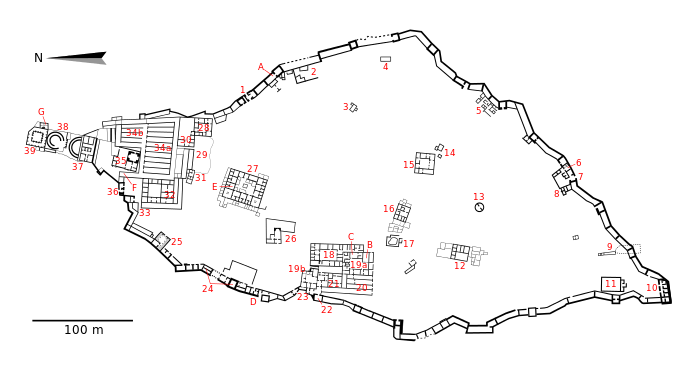 |
A. ostraca cache found in casemate B. Herod's throne room C. colorful mosaic D. Roman breaching point E. coin cache found F. ostraca cache found G. three skeletons found |
Gallery
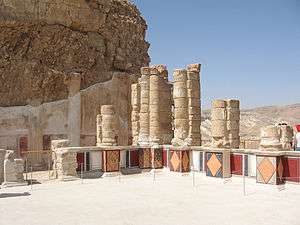 The Northern Palace's lower terrace (#39 on plan)
The Northern Palace's lower terrace (#39 on plan)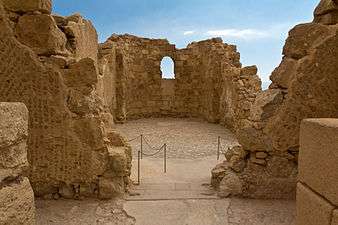 Byzantine church (#26 on plan)
Byzantine church (#26 on plan)_-_Masada_(1).jpg) Aerial view showing Masada and the Snake Path from the northeast
Aerial view showing Masada and the Snake Path from the northeast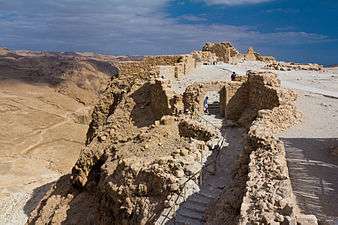 Masada's western Byzantine gate (#23 on plan)
Masada's western Byzantine gate (#23 on plan)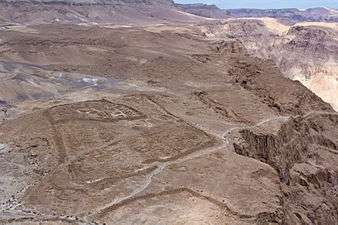 Roman siege camp F and section of the Roman circumvallation wall
Roman siege camp F and section of the Roman circumvallation wall- Cable car (Masada cableway) heading down from Masada
Legacy
World War II
The Masada story was the inspiration for the "Masada plan" devised by the British during the Mandate era. The plan was to man defensive positions on Mount Carmel with Palmach fighters, to stop Erwin Rommel's expected drive through the region in 1942. The plan was abandoned following Rommel's defeat at El Alamein.[44]
Israeli army
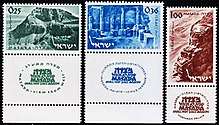
The chief of staff of the Israel Defense Forces (IDF), Moshe Dayan, initiated the practice of holding the swearing-in ceremony of Israeli Armoured Corps soldiers who had completed their tironut (IDF basic training) on top of Masada. The ceremony ended with the declaration: "Masada shall not fall again." The soldiers climbed the Snake Path at night and were sworn in with torches lighting the background.[45] These ceremonies are now also held at various other locations, including the Armoured Corps Memorial at Latrun, the Western Wall and Ammunition Hill in Jerusalem, Akko prison, and training bases.
In popular culture
- Jewish American light welterweight champion boxer Cletus Seldin wears a jacket, on the back of which is written "Remember the Masada".[46]
- Masada is a 1981 American television dramatization miniseries of the siege of Masada, based on Ernest K. Gann's historical novel The Antagonists (1971).
- Masada was a featured location during the ninth and tenth episodes of The Amazing Race Australia 1 (2011).[47]
- The Dovekeepers (2015), a two-part American television miniseries adaptation of Alice Hoffman's 2011 historical novel, dramatizes the siege of Masada.
- In 2017, Jean Michel Jarre performed an electronic music concert near the fortress.[48]
- Masada is the name of a John Zorn led jazz project exploring Jewish musical themes.
- In the television series Preacher, Masada is the headquarters of the secret organization The Grail.
See also
- Archaeology of Israel
- Gamla, an ancient site dubbed "Masada of the North"
- Psara, a similar heroic mass suicide in Greek history
- Tourism in Israel
References
-

- Most popular during 2008; "Masada tourists' favorite spot in Israel". Ynetnews. Retrieved 2009-04-08.. During 2005 to 2007 and 2009 to 2012, it was the second-most popular, behind the Jerusalem Biblical Zoo.
- Martin Mascher; et al. (18 July 2016). "Genomic analysis of 6,000-year-old cultivated grain illuminates the domestication history of barley: Supplementary Text and Figures" (PDF). Nature Genetics. Macmillan Publishers. 48 (9): 1089–93. doi:10.1038/ng.3611. ISSN 1061-4036. PMID 27428749. Retrieved 12 August 2016.
- Murphy-O'Connor, Jerome; Cunliffe, Barry (2008). The Holy Land. Oxford Archaeological Guides (5th ed.). Oxford University Press. pp. 378–381.
- Avraham Negev and Shimon Gibson (2001). "Masada". Archaeological Encyclopedia of the Holy Land. New York and London: Continuum. p. 322. ISBN 0-8264-1316-1.
- Cohen, Shaye. "Roman Domination: The Jewish Revolt and the Destruction of the Second Temple," in Ancient Israel, ed. Hershel Shanks. (Biblical Archaeology Society, 1999), pp. 269–273.
- The Wars of the Jews, or History of the Destruction of Jerusalem, by Flavius Josephus, translated by William Whiston, Project Gutenberg, Book IV, Chapter 7, Paragraph 2.
- Flavius Josephus, De bello Judaico libri vii, B. Niese, Ed. J. BJ 4.7.2
- Ancient battle divides Israel as Masada 'myth' unravels; Was the siege really so heroic, asks Patrick Cockburn in Jerusalem, The Independent, 30 March 1997
- H. M. Cotton (1989). "The date of the fall of Masada: the evidence of the Masada papyri". Zeitschrift für Papyrologie und Epigraphik. 78: 157–62.
- Gill, Dan. "A natural spur at Masada", Nature 364, pp. 569–570 (12 August 1993); doi:10.1038/364569a0
- Duncan B. Campbell, "Capturing a desert fortress: Flavius Silva and the siege of Masada", Ancient Warfare Vol. IV, no. 2 (Spring 2010), pp. 28–35. The dating is explained on pp. 29 and 32.
- UNESCO World Heritage Centre (2001-12-13). "Masada – UNESCO World Heritage Centre". Whc.unesco.org. Retrieved 2013-07-20.
- Sheppard, Si (2013). The Jewish revolt, AD 66–73. Oxford: Osprey Publishing Ltd. p. 83. ISBN 978-1-78096-183-5.
- Stiebel, Guy D. "Masada". Encyclopaedia Judaica. 13 (2nd ed.). Detroit: Macmillan Reference USA, 2007. 593–599. Gale Virtual Reference Library. Web. 10 July 2013: Michael Berenbaum and Fred Skolnik.CS1 maint: location (link)
- Nachman, Ben-Yehuda (January 1996). Masada Myth: Collective Memory and Mythmaking in Israel. p. 48. ISBN 9780299148331.
- Making History: Josephus And Historical Method. Zuleika Rodgers. 2007. p. 215. ISBN 978-9004150089.
- Joe Zias (2000). "Human Skeletal Remains from the Southern cave at Masada and the Question of Ethnicity". In L. Schiffman, J. VanderKam and M. Emanuel (ed.). The Dead Sea scrolls fifty years after their discovery. Jerusalem: Israel Exploration Society. pp. 732–738.
- https://aeon.co/essays/decoding-the-ancient-tale-of-mass-suicide-in-the-judaean-desert
- Glenda W. Friend & Steven Fine (1997). "Masada". The Oxford Encyclopedia of Archaeology in the Near East. 3. Oxford University Press. pp. 428–430.
- Yizhar Hirschfeld. The Monastery of Marda: Masada in the Byzantine Period, Bulletin of the Anglo-Israel Archaeological Society; 2001/2002, Vol. 19/20, p. 119, Jan. 2001 (abstract)
- Othmar Keel; Max Küchler; Christoph Uehlinger (1982). Orte und Landschaften der Bibel: ein Handbuch und Studien-Reiseführer zum Heiligen Land. 2. Göttingen: Vandenhoeck & Ruprecht. p. 588. ISBN 9783545230422. Retrieved 23 May 2016.
- Spokesman BIU (19 July 2016). "Genome of 6,000-year-old barley grains sequenced for first time". Bar-Ilan in the Press. Bar-Ilan University. Retrieved 12 August 2016.
- Ido Efrati (19 July 2016). "Domestication of barley began in northern Israel, 6000-year-old grains reveal". Haaretz. Retrieved 12 August 2016.
- Martin Mascher; et al. (18 July 2016). "Genomic analysis of 6,000-year-old cultivated grain illuminates the domestication history of barley". Nature Genetics. Macmillan Publishers. 48 (9): 1089–1093. doi:10.1038/ng.3611. ISSN 1061-4036. PMID 27428749.
- Ilan Ben Zion (18 July 2016). "6 millennia old but 'almost fresh,' Masada seeds unravel barley's origins". The Times of Israel. Retrieved 12 August 2016.
- My Promised Land, Ari Shavit, 2013, p. 80.
- James D. Tabor, Masada: Cave 2000/2001, on the website "The Jewish Roman World of Jesus", University of North Carolina at Charlotte. Posted no earlyer than October 1994, accessed February 2019.
- Joseph (Joe) Zias and Azriel Gorski, Capturing a Beautiful Woman at Masada, Near Eastern Archaeology (NEA) (69:1), 2006, pp. 45–48.
- Friedman, Matti (June 22, 2007). "Some Masada Remains Questioned by Study". Washington Post. Retrieved March 22, 2010.
- Connor, Steve (June 13, 2008). "2,000-year-old seed grows into 'tree of life' for scientists". London: Independent News. Archived from the original on June 14, 2008. Retrieved 2008-06-17.
- Wade, Nicholas (February 20, 2012). "Dead for 32,000 Years, an Arctic Plant Is Revived". New York Times. New York. Retrieved 2012-02-20.
- Shaye J.D. Cohen (2010). The significance of Yavneh and other essays in Jewish Hellenism. p. 143. ISBN 9783161503757.
- Zuleika Rodgers, ed. (2007). Making History: Josephus And Historical Method. Brill. p. 397.
- "The Yigael Yadin Masada Museum: Gift of the Shuki Levy Foundation". Israel Nature and Parks Authority. Archived from the original on 2015-12-29.
- "The Masada Museum in Memory of Yigael Yadin, Funded by the Shuki Levy Foundation". The Hebrew University of Jerusalem. Archived from the original on 2016-03-03. Retrieved 2016-02-07.
- "Masada Sound and Light Show". Israel Nature and Parks Authority. Archived from the original on 2015-12-29.
March to October every Tuesday and Thursday at 9 P.M.
- Seidler, Shirley (May 19, 2015). "20-year-old U.S. tourist falls to her death at Masada". Haaretz.com. Haaretz. Retrieved January 23, 2018.
- Roller, Duane W. The Building Program of Herod the Great/ Berkeley and Los Angeles: University of California Press, 1998.
- Netzer, Ehud. The Palaces of the Hasmoneans and Herod the Great. Jerusalem: Yed Ben-Zvi Press and The Israel Exploration Society, 2001.
- Yadin, Yigael. Masada: Herod's Fortress and the Zealots' Last Stand. London, 1966.
- Jerome Murphy-O'Connor (2008). The Holy Land: An Oxford Archaeological Guide from Earliest Times to 1700. Oxford Archaeological Guides. Oxford: Oxford University Press. p. 385. ISBN 978-0-19-923666-4. Retrieved 12 August 2016.
... a small, deep, stepped pool with a triangular balcony. The niches for clothes led to its identification as a swimming pool. There are those who prefer to think of it as a ritual bath (mikveh); it may well have been used as such by the Zealots.
- Mikha Livne and Ze'ev Meshel, introduction by Yigael Yadin, maps and pictures by the Masada Archaeological Expedition (1965). Masada (in French). Jerusalem: Direction des parcs nationaux.
Piscine hérodienne (Herodian swimming pool)
CS1 maint: uses authors parameter (link) - Ben-Yehuda, Nachman (1995). Masada Myth: Collective Memory and Mythmaking in Israel. University of Wisconsin Press. pp. 131–132. ISBN 9780299148331.
- Dan Bitan, Mesada the Symbol and the Legend, the Dead Sea and the Judean Desert, 1960, Yad Ben Zvi
- "On the Rise: 'Hebrew Hammer' Cletus Seldin Seeks to Join Ranks of Historic Jewish Boxers". Algemeiner.com.
- Boker, Ran (27 November 2014). "Chinese 'Amazing Race' calls off Israel shoot". Ynet. Retrieved 11 January 2020.
- "Jean-Michel Jarre to play anti-Donald Trump Dead Sea concert". The Guardian. 3 April 2017. Retrieved 18 April 2017.
Further reading
- Jodi Magness, Masada: From Jewish Revolt to Modern Myth, Princeton University Press (May 14, 2019)
- Avi-Yonah, Michael et al., Israel Exploration Journal 7, 1957, 1–160 (excavation report Masada)
- Yadin, Yigael. Masada: Herod’s Fortress and the Zealots' Last Stand. London, 1966.
- Yadin, Yigael. Israel Exploration Journal 15, 1965 (excavation report Masada).
- Netzer, Ehud. The Palaces of the Hasmoneans and Herod the Great. Jerusalem: Yed Ben-Zvi Press and The Israel Exploration Society, 2001.
- Netzer, E., Masada; The Yigael Yadin Excavations 1963–1965. Vol III. IES Jerusalem, 1991.
- Ben-Yehuda, Nachman. The Masada Myth: Collective Memory and Mythmaking In Israel, University of Wisconsin Press (December 8, 1995).
- Ben-Yehuda, Nachman. Sacrificing Truth: Archaeology and the Myth of Masada, Humanity Books, 2002.
- Bar-Nathan, R., Masada; The Yigael Yadin Excavations 1963–1965, Vol VII. IES Jerusalem, 2006.
- Jacobson, David, "The Northern Palace at Masada – Herod's Ship of the Desert?" Palestine Exploration Quarterly, 138,2 (2006), 99–117.
- Roller, Duane W. The Building Program of Herod the Great, Berkeley and Los Angeles: University of California Press, 1998.
External links
| Wikimedia Commons has media related to Masada. |
| Wikivoyage has a travel guide for Masada. |
| Wikisource has original text related to this article: |
- Photographs & footage of the Yadin excavations
- The Bible and Interpretation: The Masada Myth
- World Heritage Sites page
- Stiebel, Guy D. "Masada." Encyclopaedia Judaica. Ed. Michael Berenbaum and Fred Skolnik. 2nd ed. Vol. 13. Detroit: Macmillan Reference US, 2007. 593–599. Gale Virtual Reference Library.
- Masada photos
- Masada page on Israeli National Park website
- All the options on how to climb Masada by foot.